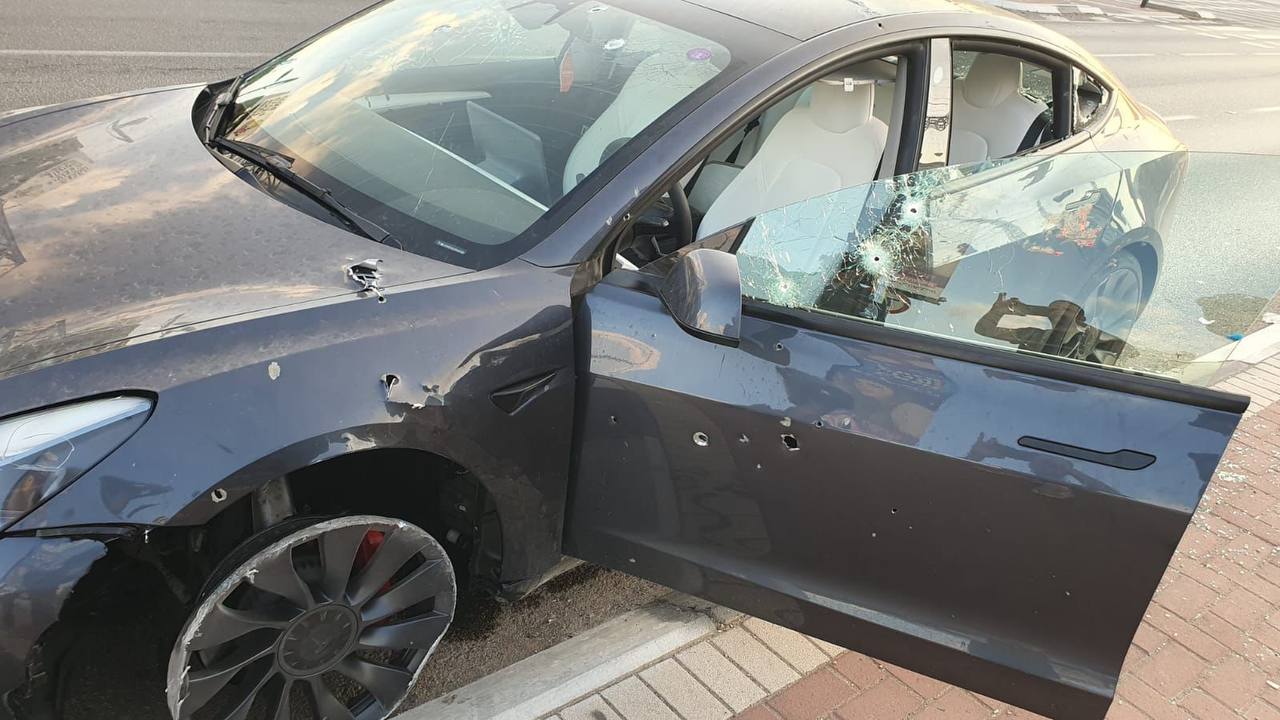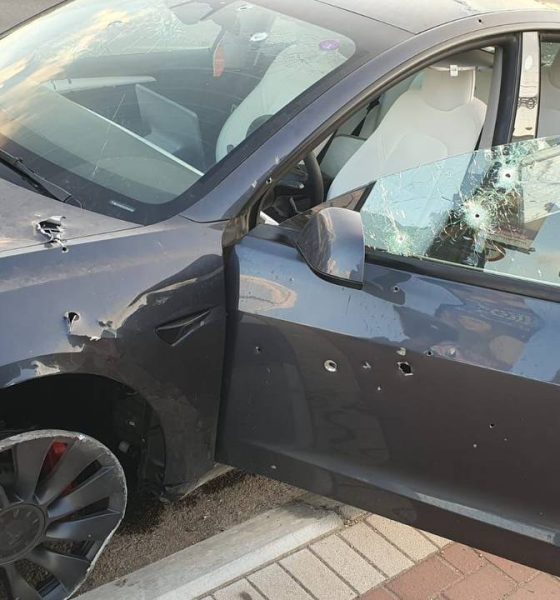As it turns out, driving a vehicle with no internal combustion engine and instant torque is quite useful when faced with literal terrorists. This was something that a Model 3 Performance owner from Israel learned firsthand when he encountered Hamas terrorists as he was heading to an assembly point.
During the beginning of Hamas’ attack, a Tesla owner from Mefalsim, a kibbutz in Southern Israel near the Gaza Strip, was called in with the community’s alert squad. As he was driving to the assembly point, he encountered a vehicle loaded with Hamas terrorists. Photos and videos of the Model 3 Performance after its run-in with the terrorists hinted at the shocking events that transpired.
Saved by Tesla. Performance version.
From Kibbutz Mefalsim to Brazilai hospital, at 180 km/h, with 1 tire missing, after terrorists sprayed Tesla with bullets.
His wife was updated on the location and his ER admission, with the real-time Tesla app.
Am Yisrael Chai @elonmusk ❤️ https://t.co/RhymORVFkV pic.twitter.com/9TTLPbiCHD— Michael Lugassy (@mluggy) October 12, 2023
Speaking from Sheba Hospital, where he is recovering from a series of surgeries due to the attack, the Tesla owner told Israeli publication Walla about his encounter. According to the Model 3 owner, the terrorists proceeded to spray the Model 3 with bullets, shooting at the front in an attempt to hit the engine. The terrorists also shot at the Model 3’s rear, seemingly in an attempt to ignite the fuel tank. Fortunately, the Model 3 Performance had neither an engine nor a fuel tank.
“The terrorists recognized me from a distance of 10 meters. In addition to their Kalashnikovs, they had a machine gun in the battle that fired bullets of a larger diameter. They didn’t realize it was an electric car, so they shot at the front, hoping to hit the engine that wasn’t there, and at the back, attempting to ignite the non-existent fuel. They shot my tires. I pressed the gas, and they started chasing me,” the Tesla owner noted.
Sorry about the language, Hebrew ? pic.twitter.com/keNJAnHIhc— Captain Eli (@TheCaptainEli) October 12, 2023
At this point, it was a matter of survival. Thankfully, the Model 3 Performance is a very quick car, and the Tesla owner was able to gain some distance from his attackers. The Model 3 owner noted that his car’s acceleration ultimately allowed him to get away, and the Tesla’s safety systems allowed him to drive to a hospital at speed, even with blown-out tires.
“They shot at my tires, but the acceleration of the Tesla is astonishing even in this situation, and the dual propulsion managed to keep us on the road. I distanced myself from them quickly, but I knew I had to reach the hospital as fast as possible, so I drove at a speed of 180 km/h (111 mph) with blown-out tires. The tires began to disintegrate, but the dual propulsion balanced the wheels, some of which were already on the rims. According to the app, I was still driving at 170-180 km/h,” he noted.
Another video from the interior
Credit to:@mluggy https://t.co/qjkzvnUpAQ pic.twitter.com/LxOZpy7FeR— Captain Eli (@TheCaptainEli) October 13, 2023
The Tesla owner was able to drive to Barzilai Hospital on his damaged Model 3. By the time the Tesla owner reached the hospital gates, his Model 3 had dozens of bullet holes, and he was bleeding from multiple injuries. Almost miraculously, the Model 3 was reportedly still operational by the time it reached the hospital. The Tesla owner’s wife was even able to track the Model 3 due to updates on the Tesla App. In later comments, the Model 3 owner noted that his next vehicle will be another Tesla.
“I took bullets in my legs and hand, and one in the skull and shrapnel. But my head works and motivation kept me on the road even now in the hospital. The car continued to drive; the battery didn’t heat up, but it took a lot. There is no part that didn’t take a bullet. It still drives if you press the gas, but it seems to me that I should already be thinking about my next Tesla,” he said.
Don’t hesitate to contact us with news tips. Just send a message to simon@teslarati.com to give us a heads up.

Elon Musk
Elon Musk and Tesla AI Director share insights after empty driver seat Robotaxi rides
The executives’ unoccupied tests hint at the rapid progress of Tesla’s unsupervised Robotaxi efforts.

Tesla CEO Elon Musk and AI Director Ashok Elluswamy celebrated Christmas Eve by sharing personal experiences with Robotaxi vehicles that had no safety monitor or occupant in the driver’s seat. Musk described the system’s “perfect driving” around Austin, while Elluswamy posted video from the back seat, calling it “an amazing experience.”
The executives’ unoccupied tests hint at the rapid progress of Tesla’s unsupervised Robotaxi efforts.
Elon and Ashok’s firsthand Robotaxi insights
Prior to Musk and the Tesla AI Director’s posts, sightings of unmanned Teslas navigating public roads were widely shared on social media. One such vehicle was spotted in Austin, Texas, which Elon Musk acknowleged by stating that “Testing is underway with no occupants in the car.”
Based on his Christmas Eve post, Musk seemed to have tested an unmanned Tesla himself. “A Tesla with no safety monitor in the car and me sitting in the passenger seat took me all around Austin on Sunday with perfect driving,” Musk wrote in his post.
Elluswamy responded with a 2-minute video showing himself in the rear of an unmanned Tesla. The video featured the vehicle’s empty front seats, as well as its smooth handling through real-world traffic. He captioned his video with the words, “It’s an amazing experience!”
Towards Unsupervised operations
During an xAI Hackathon earlier this month, Elon Musk mentioned that Tesla owed be removing Safety Monitors from its Robotaxis in Austin in just three weeks. “Unsupervised is pretty much solved at this point. So there will be Tesla Robotaxis operating in Austin with no one in them. Not even anyone in the passenger seat in about three weeks,” he said. Musk echoed similar estimates at the 2025 Annual Shareholder Meeting and the Q3 2025 earnings call.
Considering the insights that were posted Musk and Elluswamy, it does appear that Tesla is working hard towards operating its Robotaxis with no safety monitors. This is quite impressive considering that the service was launched just earlier this year.
Elon Musk
Starlink passes 9 million active customers just weeks after hitting 8 million
The milestone highlights the accelerating growth of Starlink, which has now been adding over 20,000 new users per day.

SpaceX’s Starlink satellite internet service has continued its rapid global expansion, surpassing 9 million active customers just weeks after crossing the 8 million mark.
The milestone highlights the accelerating growth of Starlink, which has now been adding over 20,000 new users per day.
9 million customers
In a post on X, SpaceX stated that Starlink now serves over 9 million active users across 155 countries, territories, and markets. The company reached 8 million customers in early November, meaning it added roughly 1 million subscribers in under seven weeks, or about 21,275 new users on average per day.
“Starlink is connecting more than 9M active customers with high-speed internet across 155 countries, territories, and many other markets,” Starlink wrote in a post on its official X account. SpaceX President Gwynne Shotwell also celebrated the milestone on X. “A huge thank you to all of our customers and congrats to the Starlink team for such an incredible product,” she wrote.
That growth rate reflects both rising demand for broadband in underserved regions and Starlink’s expanding satellite constellation, which now includes more than 9,000 low-Earth-orbit satellites designed to deliver high-speed, low-latency internet worldwide.
Starlink’s momentum
Starlink’s momentum has been building up. SpaceX reported 4.6 million Starlink customers in December 2024, followed by 7 million by August 2025, and 8 million customers in November. Independent data also suggests Starlink usage is rising sharply, with Cloudflare reporting that global web traffic from Starlink users more than doubled in 2025, as noted in an Insider report.
Starlink’s momentum is increasingly tied to SpaceX’s broader financial outlook. Elon Musk has said the satellite network is “by far” the company’s largest revenue driver, and reports suggest SpaceX may be positioning itself for an initial public offering as soon as next year, with valuations estimated as high as $1.5 trillion. Musk has also suggested in the past that Starlink could have its own IPO in the future.
News
NVIDIA Director of Robotics: Tesla FSD v14 is the first AI to pass the “Physical Turing Test”
After testing FSD v14, Fan stated that his experience with FSD felt magical at first, but it soon started to feel like a routine.

NVIDIA Director of Robotics Jim Fan has praised Tesla’s Full Self-Driving (Supervised) v14 as the first AI to pass what he described as a “Physical Turing Test.”
After testing FSD v14, Fan stated that his experience with FSD felt magical at first, but it soon started to feel like a routine. And just like smartphones today, removing it now would “actively hurt.”
Jim Fan’s hands-on FSD v14 impressions
Fan, a leading researcher in embodied AI who is currently solving Physical AI at NVIDIA and spearheading the company’s Project GR00T initiative, noted that he actually was late to the Tesla game. He was, however, one of the first to try out FSD v14.
“I was very late to own a Tesla but among the earliest to try out FSD v14. It’s perhaps the first time I experience an AI that passes the Physical Turing Test: after a long day at work, you press a button, lay back, and couldn’t tell if a neural net or a human drove you home,” Fan wrote in a post on X.
Fan added: “Despite knowing exactly how robot learning works, I still find it magical watching the steering wheel turn by itself. First it feels surreal, next it becomes routine. Then, like the smartphone, taking it away actively hurts. This is how humanity gets rewired and glued to god-like technologies.”
The Physical Turing Test
The original Turing Test was conceived by Alan Turing in 1950, and it was aimed at determining if a machine could exhibit behavior that is equivalent to or indistinguishable from a human. By focusing on text-based conversations, the original Turing Test set a high bar for natural language processing and machine learning.
This test has been passed by today’s large language models. However, the capability to converse in a humanlike manner is a completely different challenge from performing real-world problem-solving or physical interactions. Thus, Fan introduced the Physical Turing Test, which challenges AI systems to demonstrate intelligence through physical actions.
Based on Fan’s comments, Tesla has demonstrated these intelligent physical actions with FSD v14. Elon Musk agreed with the NVIDIA executive, stating in a post on X that with FSD v14, “you can sense the sentience maturing.” Musk also praised Tesla AI, calling it the best “real-world AI” today.










